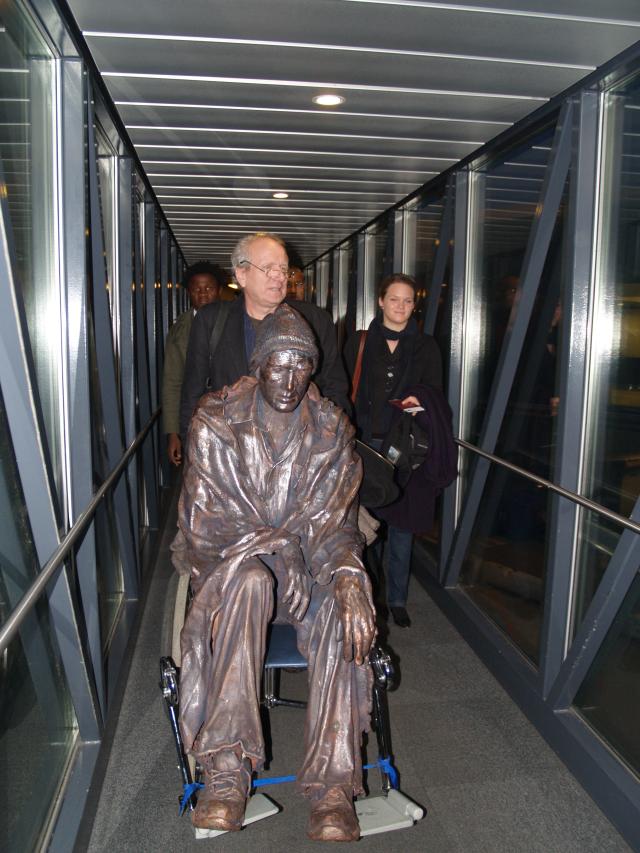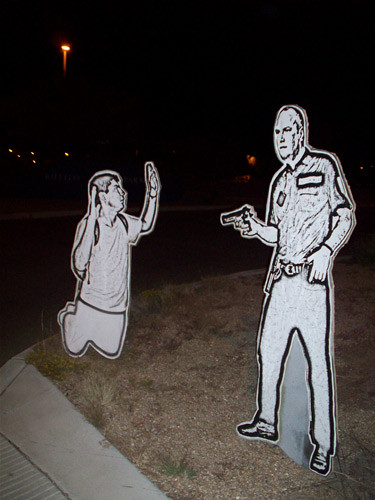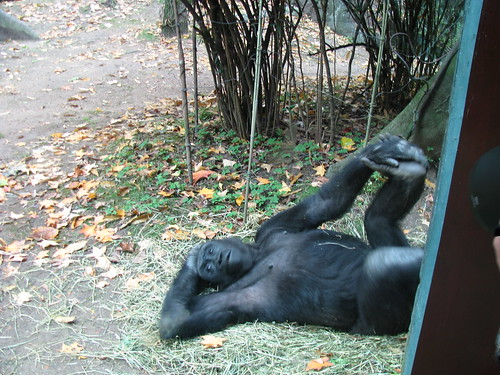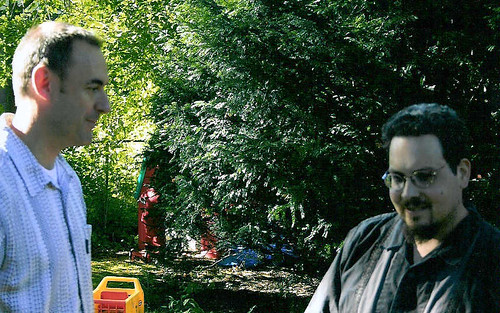|
|
Friday, November 14th, 2008
 via the Wooster Collective, I've been looking at a couple of graphics in the last few days that put me in mind of Saramago's Tuesday post about immigration. The sculpture shown to the right is Jens Galschiot's image of a homeless man, which will inaugurate his Welcome Homeless program, displaying statues of homeless people in European capitals. via the Wooster Collective, I've been looking at a couple of graphics in the last few days that put me in mind of Saramago's Tuesday post about immigration. The sculpture shown to the right is Jens Galschiot's image of a homeless man, which will inaugurate his Welcome Homeless program, displaying statues of homeless people in European capitals.
And in Tuscon, activists have been displaying cardboard cutout statues of the local right-wing sheriff and border patrol agent around town. This is pretty inspired.
posted evening of November 14th, 2008: Respond
➳ More posts about Pretty Pictures
|  |
|
The narrative style in Fortunata and Jacinta (at least, as it is filtered through this particular translator) is not exactly my preferred style. As I said before, it takes a lot of work to keep myself engaged with what's going on in the story -- in the works of fiction I really love, entering into the world of the book is an effortless thing. But that said, I think Pérez Galdós has a really exceptionally keen eye for human nature -- his observations of Juanito and Jacinta are resonating with me in a really close-to-home way. I've had a couple of moments recently of nodding my head in agreement and in surprise at the power of his depictions of their relationship. For instance, when Juanito was drunk on manzanilla and debasing himself before his new wife as a worthless cad for leaving Fortunata, I instinctively knew what was in his head -- I recognized times I've acted the same way and at the same time thought "Oh man, what an asshole he's being!" Now this is not a completely new thought -- I could have identified this behavior and its undesirability before reading this passage -- but I think Pérez Galdós' crystallization of this particular behavior pattern is striking and will stay with me. So nice from, I guess, a pædagogical angle.
posted afternoon of November 14th, 2008: Respond
➳ More posts about Fortunata and Jacinta
|  |
Wednesday, November 12th, 2008
Wow, this is unexpected and kind of exciting: Googling around for information about Benito Pérez Galdós reveals that Buñuel's Viridiana was (loosely) based on his novel Halma, and another of Buñuel's movies, Nazarín -- which I have not seen but sounds great -- is also based on a text by Pérez Galdós. Slant magazine describes Viridiana as "noticeably derivative of the similarly-themed Nazarín," which it calls "Buñuel's 1958 masterpiece." Not sure how much use this knowledge will be for me; Halma does not appear to be translated into English and I don't even know what the title of the source text for Nazarín is. Still: interesting.
 (Looks like the title of the source text for Nazarín is Nazarín -- Biblioteca Nueva published an edition of it and Halma bound together a few years back. No luck looking for translations though.) Update: Dr. Rhian Davies of the University of Sheffield has compiled a list of Pérez Galdós's works in translation. Jo Labanyi's translation of Nazarín was published in '96. No translation of Halma apparently. Dr. Davies also let me know that Buñuel's Tristana (1970) is an adaptation of Perez Galdós' work of the same title. Tristana appears in translation in Colin Partridge's book Tristana: Buñuel's Film and Galdós' Novel: A Case Study. I have pulled an essay that deals with Tristana in some detail from Google's cache.
posted afternoon of November 12th, 2008: Respond
➳ More posts about Viridiana
|  |
Tuesday, November 11th, 2008
I'll try my hand at translating another entry from Saramago's blog. (I am working from the Spanish translation.) Today he is writing about skepticism.
Some people say that skepticism is an infirmity of old age, an ailment of recent times, a sclerosis of the will. I don't dare to say this diagnosis is completely wrong, but I will say that it would be too comfortable to try to escape all difficulties through this door, as if the actual state of the world were a simple consequence of the old being old... The dreams of the young have never succeeded, at least until now, in making the world any better, and the rejuvenated bile of the old has never been enough to make it worse. Clearly the world -- poor world -- is not to blame for the evils afflicting it. That which we call the state of the world is the state of the unlucky humanity that we are, inevitably composed of old people who were young, young people who will be old, others who are not young and are not yet old. Whose fault? I hear it said that everyone bears the blame, that nobody can be presumed innocent, but I find that these sort of declarations, which appear to distribute justice evenly, are no more than spurious recurring mutations of the so-called original sin, which serve only to dilute and obscure, in an imaginary collective guilt, the responsibilities of the authentically culpable. The state, not of the world, but of life.I write this on a day in which there have arrived in Spain and in Italy hundreds of men, women and children in the fragile vessels which are used to reach the imagined paradise of a wealthy Europe. On the island of Hierro, in the Canaries, for example, there arrived such a boat, carrying inside it a dead child, and some castaways who declared that during the journey, twenty shipmates died and were cast into the sea in martyrdom... So do not speak to me of skepticism, please.
 Saramago links to Sara Prestianni's web site (in French) documenting migrants' stories, and to the NoBorders gallery on Flickr.
posted evening of November 11th, 2008: 2 responses
➳ More posts about Saramago's Notebook
|  |
|
Robyn Hitchcock is releasing (with The Venus 3) a new album on YepRoc, called Goodnight Oslo. His 15th studio album! Features among other tunes, "Up to Our Necks" and "Hurry for the Sky" -- good stuff! He is interviewed about the record in the current Paste. Here is a performance of the title track:
posted afternoon of November 11th, 2008: Respond
➳ More posts about Goodnight Oslo
|  |
Monday, November 10th, 2008
And now our attention must shift to the Dauphin's visit to his family's friend and humble servant, for if Juanito Santa Cruz had not paid that visit, this story would not have been written. Another story would surely have been written, because wherever man goes he carries his novel with him; but it would not have been this one. The narrator in Fortunata and Jacinta is an interesting case -- he refers to himself in the first person and makes reference to having met some of the characters, but he's an omniscient narrator. I'm hoping he will turn out to play a role in the story, besides as the person relating it -- it seems kind of unlikely but it would be nice.
posted evening of November 10th, 2008: Respond
➳ More posts about Benito Pérez Galdós
|  |
Sunday, November 9th, 2008
 (Darcy's library includes books about our greatest presidents.)
posted evening of November 9th, 2008: Respond
➳ More posts about Sylvia
|  |
|
As I started reading the second section of Fortunata and Jacinta, "Santa Cruz and Arnáiz: A Historical View of Madrid's Business World," I got kind of spaced out -- this is looking like a long bit of dry exposition that would give me a flavor of the novel's setting maybe, but without contributing much to my understanding of the characters -- this is what I said to myself and I started reading from a distance, not engaging myself in the text. (It did not help that there's been a long break since I read the first section, so I had to be skipping back to remind myself of characters' names.) The text is certainly very dense, and requires a good bit of effort to maintain engagement with. But a few pages in, something just clicked when I realized Barbarita was going to grow up to be Juanito's mother. (Again, I would have known this right off if I'd been paying better attention.) Suddenly all the relationships start making sense, and I'm looking at the characters as individuals rather than as representatives of families. I want to quote a long piece from Chapter 2 of this section, but will put that below the fold. The description of the (newly bourgeois) families' economic lives is holding my attention a lot better now; I'm anxious to find out why Don Baldomero will bequeath his business to his two nephews rather than to his son. Also very nice: Galdós' digression lamenting the disappearance of bright primary colors from Spanish fashion as the Spanish economy comes under the sway of the northern model -- "We're under the influence of northern Europe, and the blasted North imposes on us the grays that it gets from its smoky gray sky." Read on for a picture of Barbarita's childhood.
↷read the rest...
posted afternoon of November 9th, 2008: Respond
➳ More posts about Readings
|  |
|
 We went to the zoo and brought back pictures! We went to the zoo and brought back pictures!
posted morning of November 9th, 2008: Respond
➳ More posts about the Family Album
|  |
Saturday, November 8th, 2008
Chapter 7 of The Golden Compass is a trip. When Sylvia and I were reading it this afternoon there was a lot of talk back and forth -- "Oh, so that's what was happening!" "Oh, so that's why Lyra was at Jordan!" etc. This is a really nice trick -- there was a lot in the first part of the novel that we were just accepting on faith without really understanding, the exposition is placed so that you've just about gotten used to not being sure what's going on in the plot -- you're just reading and enjoying the characters and the action, and suddenly you turn a corner and much of the mystery is laid bare. (Not all -- there's still the central mystery of what the G.O.B. is using the kidnapped children for, and what's the city in the sky, and why is Asriel being held prisoner.)
posted evening of November 8th, 2008: Respond
➳ More posts about His Dark Materials
| Previous posts
Archives  | |
|
Drop me a line! or, sign my Guestbook.
•
Check out Ellen's writing at Patch.com.
| |

